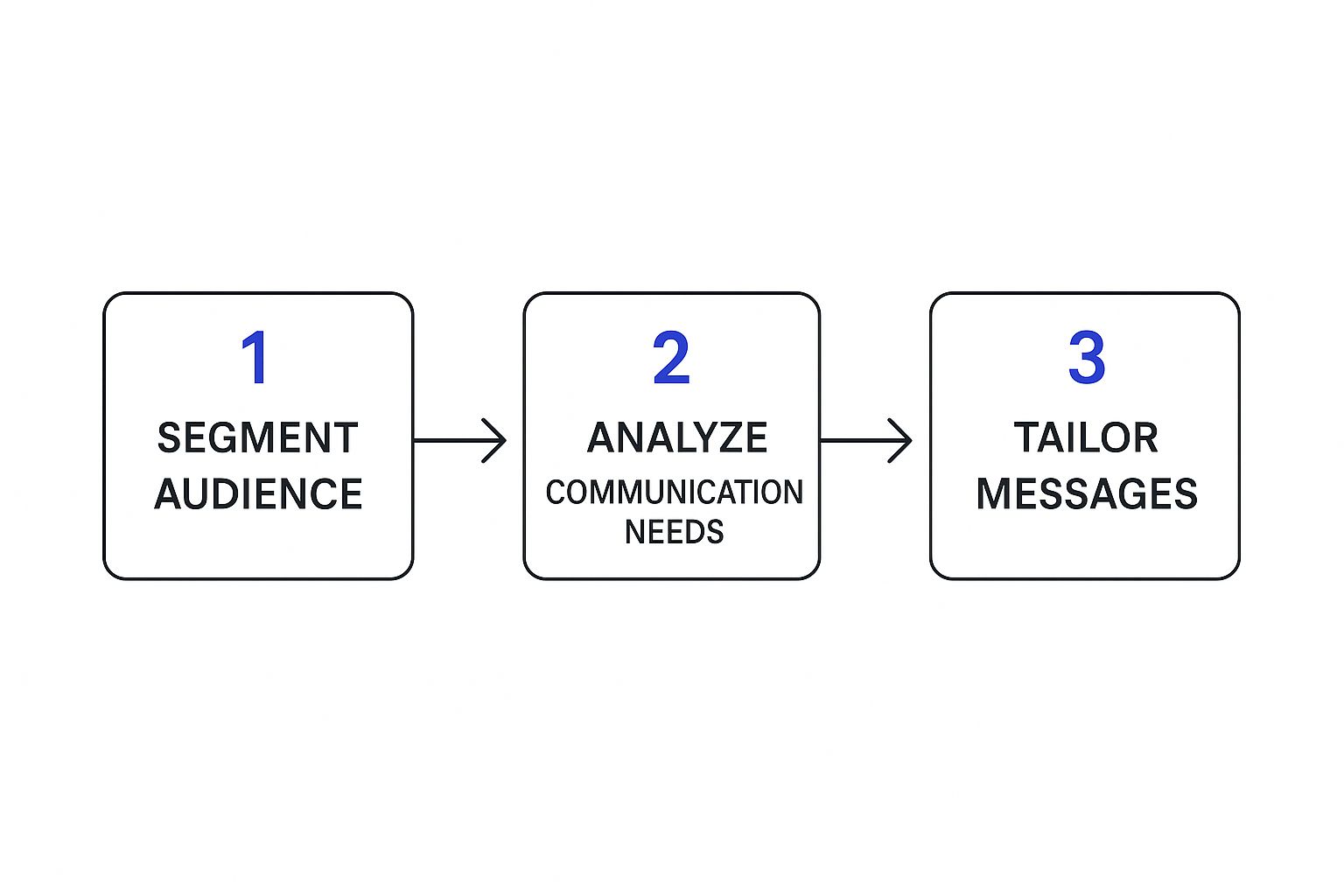Build a Winning Internal Comms Plan
Develop a strategic internal comms plan that boosts engagement and aligns your team. Get actionable insights and proven frameworks for real business impact.

Think of your internal comms plan as the strategic roadmap connecting every employee to your company's mission. It’s the documented strategy that ensures the right people get the right message at the right time—preventing chaos and aligning your entire team.
Why a Strategic Comms Plan Is Your Secret Weapon

Let's move beyond the textbook definition. A truly strategic internal comms plan is far more than an HR document or a simple content calendar. It's the central nervous system for your entire organization and a core driver of business success. Without one, you're essentially flying blind.
Imagine a company launching a major new tech platform. With no cohesive plan, the announcement is a confusing mess of conflicting emails from IT, HR, and department heads. Employees are left frustrated, adoption rates plummet, and productivity grinds to a halt. This isn't just a communication breakdown; it's a business failure.
Now, picture that same scenario with a strong plan in place. The rollout is orchestrated. Messages are tailored for different teams. Leaders are equipped with clear talking points. The result? Clarity, confidence, and a smooth transition. That’s the real-world impact of strategic communication.
Driving Engagement and Productivity
An effective plan does more than just inform; it actively engages. When people understand the "why" behind company decisions and see how their work contributes to the bigger picture, their connection to the organization deepens. This is especially vital in hybrid and remote settings where organic connection is much harder to come by.
And engagement isn't just a soft metric. It has a direct line to tangible business outcomes:
- Higher Productivity: Aligned teams waste less time deciphering mixed signals and more time executing on shared goals.
- Improved Retention: Employees who feel informed and valued are far less likely to look for opportunities elsewhere.
- Stronger Culture: Consistent, authentic communication reinforces your company's values and builds a real foundation of trust.
A well-crafted internal comms plan is also your best defense against information silos, low morale, and the pervasive issue of change fatigue. Research shows that the average employee faced 10 planned organizational changes in 2022—a massive fivefold increase from 2016. Every single one of those changes is a risk for disengagement if not managed well.
An internal comms plan isn’t about sending more emails. It’s about building a resilient organization where everyone feels seen, heard, and connected to the mission. It transforms communication from a simple task into a powerful business tool.
The Foundation of Trust
Ultimately, the goal is to create a predictable, reliable flow of information. That consistency is what builds trust, which is the bedrock of any successful company.
When employees trust leadership, they're more receptive to change, more willing to go the extra mile, and more likely to become advocates for the business. Crafting an effective comms plan is the first and most critical step. For those looking to dive deeper into day-to-day execution, you can explore our resources to improve workplace communication with actionable tips.
Take a Hard Look at Your Current Communication Landscape
Before you can build a better internal communications plan, you have to get honest about what’s happening right now. Trying to launch a new strategy without first auditing your current state is like trying to navigate a city with a map of a different town—you're going to end up lost. This is where you stop guessing and start gathering real evidence.
A good audit isn’t just a quick list of your comms channels. It’s a deep dive into what’s actually working, what’s falling flat, and what your employees are completely ignoring.
Who Are You Actually Talking To?
Your company isn't one big, uniform group. It's a mix of distinct audiences, each with their own needs, priorities, and daily grind. The all-hands email that resonates with your C-suite is probably getting deleted unread by your frontline warehouse team. Smart communication starts by acknowledging this.
The first step is to break down your workforce into meaningful segments. You can group people by:
- Role or Function: Think Sales vs. Engineering vs. Customer Support. They care about different things.
- Location: Are they at headquarters, in a regional office, or fully remote? This changes how they receive information.
- Work Style: Do they sit at a desk all day or are they non-desk workers who rarely touch a computer?
- Level: Your execs, middle managers, and individual contributors all have different perspectives.
Once you have these groups defined, you can start digging into what they really need to hear and how they prefer to hear it. This is how you make sure your new plan is targeted and actually gets results.

This workflow is simple but powerful. You can’t craft a message that hits the mark until you know who you’re aiming for.
Gather the Real Story (Not Just the Numbers)
Data is your best friend here. You need a mix of hard numbers and human stories to see the full picture of what’s going on.
Start with a quantitative audit. This is the easy part. Pull the numbers on your existing channels: email open rates, intranet page views, engagement on your chat platforms, and attendance at company meetings. This data tells you what is happening.
Next, you need a qualitative audit to understand why it's happening. This is where you get the human context behind the metrics.
- Employee Surveys: Send out anonymous surveys to get honest feedback. Ask direct questions like, "On a scale of 1-5, how connected do you feel to the company's mission?" or "Which communication channel do you trust the most for important news?"
- Focus Groups: Get small, diverse groups of employees in a room for a real conversation. This is where you’ll uncover the stuff surveys miss—like finding out that while everyone opens the CEO's email, nobody believes it.
To help you systematically evaluate your current efforts, use a simple checklist. This will give you a clear, at-a-glance view of your strengths and weaknesses before you start building your new strategic plan.
Internal Comms Audit Checklist
Once you've run through this checklist, you’ll have a much clearer picture of where the biggest gaps are and what you need to prioritize.
Turn Your Findings into SMART Objectives
Now for the final, most important step of your audit: turning all that data into clear, actionable goals for your new plan. Just collecting survey results isn’t enough. And if you find yourself drowning in spreadsheets, it might be worth learning how to automate data entry so you can spend more time on strategy and less on manual data wrangling.
Your audit might uncover some hard truths, like only 9% of your non-desk employees feel well-informed, or that your project teams are completely overwhelmed by irrelevant emails. These insights are gold. They become the foundation of your objectives.
Every objective you set should be SMART:
- Specific: Not "Improve comms," but "Improve communication with our non-desk employees."
- Measurable: "Increase the open rate of our weekly operations update by 20%."
- Achievable: Set a realistic goal based on your starting numbers.
- Relevant: Make sure the goal supports a bigger business objective, like improving safety or productivity.
- Time-bound: "...within the next quarter."
A great objective, born directly from your audit, might sound something like this: "Increase non-desk employee engagement with weekly safety updates by 30% in Q3 by rolling out a mobile-first digest and adding a quick topic review to manager-led huddles."
That’s a goal with teeth. It's specific, measurable, and gives your entire internal comms plan a clear purpose and a way to prove its success.
Designing the Core of Your Comms Plan

Okay, you’ve done the audit and set your objectives. Now for the fun part: building the engine of your internal comms plan. This is where we move from high-level strategy to a concrete blueprint for what you’ll say, how you’ll say it, and how you’ll listen.
A great plan isn't just a schedule of announcements. It's a system designed to drive clarity and connection across the entire company. Getting the core components right—your key messages, company voice, and feedback loops—is what separates comms that make an impact from noise that gets ignored.
Crafting and Cascading Key Messages
At its heart, your comms plan is all about managing the flow of information. That flow starts with your key messages: the handful of foundational ideas you need every single employee to hear, understand, and act on.
These aren't just fluffy taglines. They should be tied directly to the business objectives you uncovered during your audit. Think of them as the pillars holding up your entire communication structure—concise, memorable statements that spell out the "what," "why," and "what's next."
For instance, if your company is rolling out a major new piece of technology, your messages might look like this:
- What: We're implementing a new CRM to unify all our customer data.
- Why: This will create a single source of truth, helping us serve customers faster and more effectively.
- What's Next: Role-based training starts in Q3, and you’ll get a personalized learning path.
Once you have your core messages, you need to cascade them. This doesn't mean just copy-pasting the same announcement to every department. It means translating the core idea for different audiences.
A critical mistake is believing that one message fits all. The most effective internal comms plan translates core ideas into language that resonates with specific teams, addressing their unique concerns and motivations directly.
Let's use a real-world scenario. Imagine your company is launching a more generous benefits policy.
- For the Engineering Team: You'd probably highlight the better mental health resources and flexible work options, framing them as a way to support deep work and innovation.
- For the Sales Team: You might focus on the improved commission structure and family leave policies, connecting them to high performance and better work-life balance.
The central message—"We are investing more in our people's well-being and success"—doesn’t change. But the delivery is tailored to answer each team's unspoken question: "What's in it for me?"
Establishing an Authentic Company Voice
How you say something is just as important as what you say. Your company voice is the personality behind your communications. Is it formal and authoritative? Casual and collaborative? Data-driven and direct?
There’s no one-size-fits-all answer, but whatever you choose, it must be consistent and authentic. An inconsistent voice kills trust faster than almost anything. If the CEO's emails are stuffed with corporate jargon but the intranet is covered in memes, people won't know which one reflects the real culture.
Your voice should be a direct reflection of your company's values. If "transparency" is a core value, your comms need to be open, honest, and willing to tackle tough questions. If "innovation" is a value, your voice should feel energetic and forward-thinking.
A simple way to nail this down is to pick three or four descriptive words. For example:
- Supportive
- Clear
- Forward-looking
These words become a compass for anyone creating internal content, ensuring everything from HR announcements to leadership updates sounds like it’s coming from the same company.
Engineering Feedback Loops for Two-Way Conversation
A plan that only broadcasts information is doomed from the start. Great internal comms is a two-way street. Building intentional feedback loops is non-negotiable if you want employees to feel engaged and heard. It’s what turns a monologue into a genuine conversation.
This means your plan must create deliberate opportunities for people to ask questions, share ideas, and voice concerns. We're talking about more than a dusty, old suggestion box. It's about embedding dialogue into your daily operations.
Here are a few effective feedback mechanisms:
- Manager-Led Listening Sessions: Give managers the tools and structure to hold regular, open conversations with their teams about company news and gather input.
- "Ask Me Anything" (AMA) Sessions: Host AMAs with leadership on platforms like Slack or Teams, where questions can be submitted and upvoted by everyone.
- Pulse Surveys: After a big announcement, send out short, frequent surveys to get a quick read on how the message landed and what the general sentiment is.
- Dedicated Channels: Create a specific home for feedback, like an #ideas-and-feedback channel in Slack, so employees know exactly where to go.
The most critical part? You have to close the loop. When people share feedback, they need to see it was received and considered. This can be as simple as sharing a summary of survey results or having a leader address the top AMA questions in the next all-hands meeting. Acknowledging feedback—even if you can't act on it—is fundamental to building trust.
Choosing Your Channels for Maximum Engagement

A brilliant message is useless if it lands in an empty room. Crafting the perfect announcement for your internal comms plan is only half the battle; ensuring it reaches your team in the right place, at the right time, is where real engagement happens. This means getting strategic and building a communication ecosystem, not just a series of one-off blasts.
The goal isn't to be everywhere at once. It’s to be intentional. Blasting the same update across email, Slack, and the intranet doesn't create clarity—it just creates noise. The smartest plans map specific messages to specific channels based on who needs to hear it and how urgent it is.
This is how you avoid the dreaded "communication overload" that plagues so many workplaces. When employees know where to look for certain types of information, they pay more attention. Urgent operational updates might belong on a mobile app notification, while in-depth project resources have a permanent home on the company intranet.
Aligning Channels with Your Audience
The most effective channel strategy starts with a simple question: where is my audience? Your corporate office team might live in Microsoft Teams all day, but your frontline workers in a warehouse or retail store may never even log in. A strong plan acknowledges these differences and builds bridges to every employee segment.
This is especially true for the non-desk workforce, who make up a staggering 80% of the global workforce but are often the most disconnected. If you're only using email or an intranet that requires a desktop, you're leaving them behind. This is where tools like dedicated mobile apps or even SMS alerts become invaluable.
Think about the message itself, too. Is it a quick, informal celebration of a team win? Perfect for a chat channel. Is it a complex policy change that people will need to reference later? That belongs on the intranet, where it can be easily found and stored.
Don't make your employees hunt for information. A great channel strategy brings the information to them in a predictable, reliable way. This builds trust and ensures your most critical updates actually cut through the noise.
The Modern Communication Mix
Today’s communication landscape is a blend of digital and physical touchpoints. A truly effective internal comms plan uses this mix to create a richer, more engaging experience for everyone. This multi-channel approach is quickly becoming standard practice for forward-thinking organizations.
The data shows a clear trend towards strategic diversification. Companies are increasingly relying on intranets (77%), collaboration tools like Microsoft Teams (63%), and digital events (58%). At the same time, the value of face-to-face interaction has rebounded, with in-person event participation rising to 69%. This highlights the need for a blended approach that combines digital efficiency with the impact of personal connection. You can discover more 2025 internal comms trends to see how other companies are adapting.
Let’s break down the pros and cons of a few key channels:
By understanding the strengths and weaknesses of each channel, you can build a smarter, more effective communication flow. Your plan should clearly define the purpose of each platform, turning a chaotic jumble of tools into an orchestrated system that works for everyone.
Measuring What Matters to Build Lasting Trust
An internal comms plan without measurement is just a bunch of hopeful guesses. If you want to build real, lasting trust, you have to connect what you're doing to what the business actually cares about. This means ditching the old-school vanity metrics like email open rates and digging into what truly moves the needle: employee engagement, sentiment, and the overall resilience of your organization.
Think of your plan as a living document, one that's constantly getting smarter with data. When you're transparent about what you're measuring—and what the results are—you're sending a powerful message to employees that you're listening. It also proves your value to leadership. In a climate where things can change overnight, this data-driven approach is what holds a connected organization together.
Moving Beyond Vanity Metrics
For far too long, internal communicators have been stuck on metrics that are easy to track but ultimately shallow. Sure, an email open rate of 70% looks fantastic on a presentation slide, but what does it actually tell you? It reveals nothing about whether the message was understood, believed, or acted upon. Did it change anyone's behavior? Did it make people feel more confident in the company's direction?
To measure what really matters, you have to shift your focus from output to impact. It’s time to build a KPI dashboard that tracks the real-world effects of your internal comms plan.
- Engagement Metrics: Instead of just counting page views on an intranet article, look at time on page, scroll depth, and how many people shared it. For videos, the completion rate tells a much richer story.
- Behavioral Change: Are employees actually using the new software you announced? Are they signing up for the wellness programs you've been promoting? You need to draw a direct line from your communications to these actions.
- Feedback Analysis: Pay attention to the volume and sentiment of questions during AMAs or comments on intranet posts. Are people confused? Excited? Concerned? This is gold.
This shift requires you to think more like a marketer, analyzing how your "internal customers"—your employees—are actually interacting with the information you're putting out there.
An effective measurement strategy answers one simple question: "Did our communication make a difference?" If you can't answer that, you're just adding to the noise.
Linking Communication to Business Outcomes
The absolute best way to show how valuable your internal comms plan is? Link it directly to core business goals. When you can draw a clear line from better communication to lower turnover or higher productivity, your plan stops being a "nice to have" and becomes an essential strategic tool.
For example, a manufacturing company might see a 15% reduction in workplace incidents after launching a new mobile safety communication campaign. An IT firm could link a clear, multi-channel rollout of new software to a 40% increase in adoption rates in the first month.
This is how you get leadership to sit up and take notice. It’s not about sending more messages; it’s about sending the right messages that drive real, measurable results. This kind of data-backed approach also helps improve how the business runs as a whole, much like how data can boost customer service efficiency by spotlighting and fixing customer pain points.
The Critical Non-Desk Communication Gap
Nowhere is measurement more vital than with your non-desk workforce. These are often the employees who are hardest to reach and feel the most disconnected from corporate messaging, which creates a huge trust gap. And the data paints a pretty stark picture of this challenge.
A recent study revealed that while employee satisfaction with internal comms is a global problem, it's especially dire for non-desk workers. A shocking 38% of all employees rate their organization's communication quality as poor. It gets worse: only 9% of non-desk employees say they're very satisfied. This deep dissatisfaction isn't just a number—it highlights a massive opportunity. In today's economic climate, trust is your most valuable currency, and communication is the very bedrock of engagement and resilience. You can read the full 2025 study findings on communication impact to really grasp the urgency here.
By tracking metrics specific to this audience—like mobile app engagement or feedback from shift huddles—you can finally start closing this critical gap.
Continuously Refining Your Plan with Data
Your KPI dashboard isn't a report you create once and forget about. It's your compass for continuous improvement. The data you collect should be used to constantly tweak and refine your internal comms plan.
- Seeing low engagement on a particular channel? It might be time to re-evaluate its purpose or the kind of content you're sharing there.
- Noticing a lot of questions about a specific topic? That’s your cue to create a dedicated FAQ or a resource page.
- Is sentiment analysis showing widespread confusion? Go back and rework your key messages to make them clearer.
When you regularly review your metrics and adjust your strategy, you create a responsive, agile communication function that evolves right alongside your organization. This iterative process is what keeps your plan relevant, effective, and a powerful force for building trust and alignment.
Of course, even with the best guide in hand, questions always come up when you’re in the thick of it. Building or refining an internal comms plan is a big job.
Let’s tackle some of the most common questions that leaders and communicators run into. Here are a few clear, practical answers to help you sidestep common roadblocks and make your strategy even stronger.
How Often Should We Update Our Plan?
Your internal comms plan should be a living document—not a static file that collects dust on a shared drive. Think of it less like a finished painting and more like a garden that needs regular attention to thrive.
A full, top-to-bottom review should happen annually. This is your chance to align the plan with the company's new business goals and strategic priorities for the year ahead.
But don't wait a full year to make tweaks. Be ready to revisit it quarterly or whenever something big happens. This could be anything from a merger or a major leadership change to a shift in your company's work model. Use regular pulse surveys and feedback to make smaller, ongoing adjustments to tactics and channels. This agility is what keeps your plan relevant and effective.
What Is the Biggest Mistake to Avoid?
By far, the most common and damaging mistake is treating communication as a one-way, top-down broadcast. It's a relic of a bygone era. This approach completely misses the need for dialogue and is the fastest way to make employees feel disconnected, ignored, and unheard. It absolutely erodes trust.
A successful plan has to be built with feedback mechanisms from the ground up. You need to engineer opportunities for two-way conversation so it becomes the norm, not the exception.
- "Ask Me Anything" (AMA) Sessions: Run regular, unfiltered Q&A sessions with leadership to build transparency.
- Manager-Led Listening Tours: Give managers the tools and training to facilitate honest conversations and report themes back up.
- Accessible Pulse Surveys: Use quick, targeted surveys after major announcements to get a real-time read on understanding and sentiment.
Fostering a culture where conversation flows in both directions is the single most important part of a modern internal comms plan.
The goal isn't just to be heard; it's to listen. A plan that only pushes information out is fundamentally broken. True engagement begins when you create systems that actively pull employee voices in.
How Can I Get Leadership to Support a New Comms Plan?
If you want buy-in from the C-suite, you have to speak their language: business results. Ditch the comms jargon and connect your plan directly to their biggest priorities. You need to show them how a strategic approach isn't just a "nice-to-have," but a crucial tool for hitting key objectives.
Start by presenting data from your communications audit. Highlight the current gaps and show their potential business impact. For example, you could show how poor communication with frontline teams correlates with higher safety incidents or lower productivity.
Use industry benchmarks to demonstrate how your plan can mitigate risk and drive a real return on investment. Make a clear, data-backed case for how your internal comms plan will:
- Reduce costly employee turnover by improving engagement.
- Boost productivity during a major organizational change.
- Strengthen alignment with critical business goals.
When you frame your plan as a solution to their problems, it stops being an expense and becomes an investment.
How Does a Comms Plan Help with Message Overload?
It might sound counterintuitive, but a formal plan is your best defense against communication chaos. Without one, every department sends messages on its own schedule through whatever channel it prefers. The result? A relentless firehose of information that completely overwhelms employees.
A strong internal comms plan brings order to that chaos. It establishes a clear channel strategy, which designates specific platforms for specific types of messages.
For example:
This simple structure creates predictability. It teaches employees where to look for what information. The plan also relies on a master content calendar to manage the timing and flow of messages, preventing different teams from bombarding employees all at once. It’s all about cutting through the noise so the truly important messages can be heard loud and clear.
Ready to stop the communication chaos and build a truly connected team? Chatiant lets you create custom AI agents and chatbots trained on your company's unique data. Answer employee questions instantly, automate onboarding tasks, and deliver personalized information right where your teams work—in Google Chat, Slack, or on your intranet. Learn how to transform your internal communications at https://www.chatiant.com.


